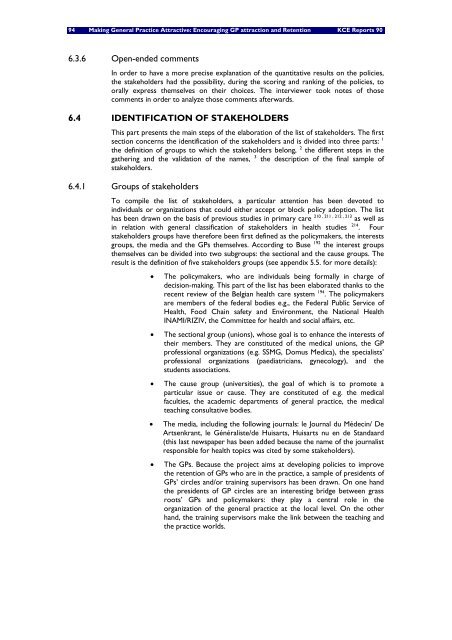Download the report (150 p.) - KCE
Download the report (150 p.) - KCE
Download the report (150 p.) - KCE
You also want an ePaper? Increase the reach of your titles
YUMPU automatically turns print PDFs into web optimized ePapers that Google loves.
94 Making General Practice Attractive: Encouraging GP attraction and Retention <strong>KCE</strong> Reports 90<br />
6.3.6 Open-ended comments<br />
In order to have a more precise explanation of <strong>the</strong> quantitative results on <strong>the</strong> policies,<br />
<strong>the</strong> stakeholders had <strong>the</strong> possibility, during <strong>the</strong> scoring and ranking of <strong>the</strong> policies, to<br />
orally express <strong>the</strong>mselves on <strong>the</strong>ir choices. The interviewer took notes of those<br />
comments in order to analyze those comments afterwards.<br />
6.4 IDENTIFICATION OF STAKEHOLDERS<br />
This part presents <strong>the</strong> main steps of <strong>the</strong> elaboration of <strong>the</strong> list of stakeholders. The first<br />
section concerns <strong>the</strong> identification of <strong>the</strong> stakeholders and is divided into three parts: 1<br />
<strong>the</strong> definition of groups to which <strong>the</strong> stakeholders belong, 2 <strong>the</strong> different steps in <strong>the</strong><br />
ga<strong>the</strong>ring and <strong>the</strong> validation of <strong>the</strong> names, 3 <strong>the</strong> description of <strong>the</strong> final sample of<br />
stakeholders.<br />
6.4.1 Groups of stakeholders<br />
To compile <strong>the</strong> list of stakeholders, a particular attention has been devoted to<br />
individuals or organizations that could ei<strong>the</strong>r accept or block policy adoption. The list<br />
has been drawn on <strong>the</strong> basis of previous studies in primary care 210 , 211 , 212 , 213 as well as<br />
in relation with general classification of stakeholders in health studies 214 . Four<br />
stakeholders groups have <strong>the</strong>refore been first defined as <strong>the</strong> policymakers, <strong>the</strong> interests<br />
groups, <strong>the</strong> media and <strong>the</strong> GPs <strong>the</strong>mselves. According to Buse 192 <strong>the</strong> interest groups<br />
<strong>the</strong>mselves can be divided into two subgroups: <strong>the</strong> sectional and <strong>the</strong> cause groups. The<br />
result is <strong>the</strong> definition of five stakeholders groups (see appendix 5.5. for more details):<br />
• The policymakers, who are individuals being formally in charge of<br />
decision-making. This part of <strong>the</strong> list has been elaborated thanks to <strong>the</strong><br />
recent review of <strong>the</strong> Belgian health care system 194 . The policymakers<br />
are members of <strong>the</strong> federal bodies e.g., <strong>the</strong> Federal Public Service of<br />
Health, Food Chain safety and Environment, <strong>the</strong> National Health<br />
INAMI/RIZIV, <strong>the</strong> Committee for health and social affairs, etc.<br />
• The sectional group (unions), whose goal is to enhance <strong>the</strong> interests of<br />
<strong>the</strong>ir members. They are constituted of <strong>the</strong> medical unions, <strong>the</strong> GP<br />
professional organizations (e.g. SSMG, Domus Medica), <strong>the</strong> specialists’<br />
professional organizations (paediatricians, gynecology), and <strong>the</strong><br />
students associations.<br />
• The cause group (universities), <strong>the</strong> goal of which is to promote a<br />
particular issue or cause. They are constituted of e.g. <strong>the</strong> medical<br />
faculties, <strong>the</strong> academic departments of general practice, <strong>the</strong> medical<br />
teaching consultative bodies.<br />
• The media, including <strong>the</strong> following journals: le Journal du Médecin/ De<br />
Artsenkrant, le Généraliste/de Huisarts, Huisarts nu en de Standaard<br />
(this last newspaper has been added because <strong>the</strong> name of <strong>the</strong> journalist<br />
responsible for health topics was cited by some stakeholders).<br />
• The GPs. Because <strong>the</strong> project aims at developing policies to improve<br />
<strong>the</strong> retention of GPs who are in <strong>the</strong> practice, a sample of presidents of<br />
GPs’ circles and/or training supervisors has been drawn. On one hand<br />
<strong>the</strong> presidents of GP circles are an interesting bridge between grass<br />
roots’ GPs and policymakers: <strong>the</strong>y play a central role in <strong>the</strong><br />
organization of <strong>the</strong> general practice at <strong>the</strong> local level. On <strong>the</strong> o<strong>the</strong>r<br />
hand, <strong>the</strong> training supervisors make <strong>the</strong> link between <strong>the</strong> teaching and<br />
<strong>the</strong> practice worlds.
















